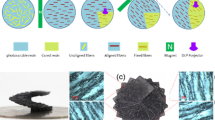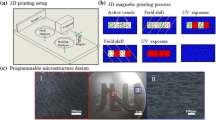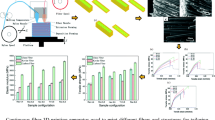Abstract
Fiber is a crucial element in biological micro-structural materials. Replication of fiber-reinforced composites with analogous architectures of their natural counterparts has caused widespread academic concern. Recent researches indicate 3D printing technology has the potential to produce biomimetic structural materials. The aim of this study is to develop a process to fabricate fiber-reinforced composites with ordered yet spatially tunable fiber arrangement. Specifically, we present a method to align fibers during the 3D printing of fiber-reinforced composites. A modified slurry-based stereolithography process was developed, and the fibers in the fiber–resin mixture were aligned by Shear force produced during the spreading of slurry. We investigated the influence of relative factors on fiber orientation, and two models were used to uncover the internal mechanism. By controlling the speed and the direction of the moving blade, the patterns that fibers were arranged can be freely programmed. Therefore, we have extracted bioinspired sinusoidal and zigzag design motifs to analyze their mechanical properties compared with non-bioinspired motifs. The proposed method is relatively material agnostic, more efficient and more facile. It thus provides a promising route to fabricate fiber-reinforced composites, and has potential to be adopted in biological structures researches and industrial applications.









Similar content being viewed by others
References
Wegst, U. G., Bai, H., Saiz, E., Tomsia, A. P., & Ritchie, R. O. (2015). Bioinspired structural materials. Nature Materials, 14(1), 23–36.
Naleway, S. E., Porter, M. M., Mckittrick, J., & Meyers, M. A. (2015). Structural design elements in biological materials: Application to bioinspiration. Advanced Materials, 27(37), 5455–5476.
Grunenfelder, L. K., Suksangpanya, N., Salinas, C., Milliron, G., Yaraghi, N., Herrera, S., et al. (2014). Bio-inspired impact-resistant composites. Acta Biomaterialia, 10(9), 3997–4008.
Kim, J. H., Shim, B. S., Kim, H. S., Lee, Y. J., Min, S. K., Jang, D., et al. (2015). Review of nanocellulose for sustainable future materials. International Journal of Precision Engineering and Manufacturing-Green Technology, 2(2), 197–213.
Weaver, J. C., Milliron, G. W., Miserez, A., Evans-Lutterodt, K., Herrera, S., Gallana, I., et al. (2012). The stomatopod dactyl club: A formidable damage-tolerant biological hammer. Science, 336(6086), 1275.
Tanner, K. E. (2012). Small but extremely tough. Science, 336(6086), 1237–1238.
Amini, S., Tadayon, M., Idapalapati, S., & Miserez, A. (2015). The role of Quasi-plasticity in the extreme contact damage tolerance of the stomatopod dactyl club. Nature Materials, 14(9), 943.
Amini, S., Masic, A., Bertinetti, L., Teguh, J. S., Herrin, J. S., Zhu, X., et al. (2014). Textured fluorapatite bonded to calcium sulphate strengthen stomatopod raptorial appendages. Nature Communications, 5(1), 3187.
Patek, S. N., Korff, W. L., & Caldwell, R. L. (2004). Biomechanics: Deadly strike mechanism of a mantis shrimp. Nature, 428(6985), 819.
Lim, Y., Park, J., & Park, K. (2018). Automatic design of 3D conformal lightweight structures based on a tetrahedral mesh. International Journal of Precision Engineering and Manufacturing-Green Technology, 5(4), 499–506.
Martin, J. J., Fiore, B. E., & Erb, R. M. (2015). Designing bioinspired composite reinforcement architectures via 3D magnetic printing. Nature Communications, 6, 8641.
Yang, Y., Chen, Z., Song, X., Zhang, Z., Zhang, J., Shung, K. K., et al. (2017). Biomimetic anisotropic reinforcement architectures by electrically assisted nanocomposite 3D printing. Advanced Materials, 29, 1605750.
Collino, R. R., Ray, T. R., Fleming, R. C., Sasaki, C. H., Haj-Hariri, H., & Begley, M. R. (2015). Acoustic field controlled patterning and assembly of anisotropic particles. Extreme Mechanics Letters, 5, 37–46.
Walther, A., Bjurhager, I., Malho, J. M., Pere, J., Ruokolainen, J., Berglund, L. A., et al. (2010). Large-area, lightweight and thick biomimetic composites with superior material properties via fast, economic, and green pathways. Nano Letters, 10(8), 2742–2748.
Mirkhalaf, M., & Barthelat, F. (2016). Nacre-like materials using a simple doctor blading technique: Fabrication, testing and modeling. Journal of the Mechanical Behavior of Biomedical Materials, 56, 23–33.
Christ, S., Schnabel, M., Vorndran, E., Groll, J., & Gbureck, U. (2015). Fiber reinforcement during 3D printing. Materials Letters, 139, 165–168.
Yaraghi, N. A., Guarín Zapata, N., Grunenfelder, L. K., Hintsala, E., Bhowmick, S., Hiller, J. M., et al. (2016). A sinusoidally architected helicoidal biocomposite. Advanced Materials, 28(32), 6835–6844.
Tsai, P. J., Ghosh, S., Wu, P., & Puri, I. K. (2016). Tailoring material stiffness by filler particle organization. ACS Applied Materials & Interfaces, 8(41), 27449–27453.
Mahajan, C., Cormier, D. (2015). 3D printing of carbon fiber composites with preferentially aligned fibers. In IIE Annual Conference Proceedings Institute of Industrial Engineers, Inc. (IIE)
Shah, A. U. R., Prabhakar, M. N., & Song, J. (2017). Current advances in the fire retardancy of natural fiber and bio-based composites—A review. International Journal of Precision Engineering and Manufacturing-Green Technology, 4(2), 247–262.
Jeffery, G. B. (1922). The motion of ellipsoidal particles immersed in a viscous fluid. Proceedings of the Royal Society A, 102(715), 161–179.
Moses, K. B., Advani, S. G., & Reinhardt, A. (2001). Investigation of fiber motion near solid boundaries in simple shear flow. Rheologica Acta, 40(3), 296–306.
Ranganathan, S., & Advani, S. G. (1991). Fiber–fiber interactions in homogeneous flows of nondilute suspensions. Journal of Rheology, 35(35), 1499–1522.
Guell, D., & Bénard, A. (1997). Flow-induced alignment in composite materials: Current applications and future prospects. In Flow-Induced Alignment in Composite Materials (pp. 1–42).
Cox, R. G. (2006). The motion of long slender bodies in a viscous fluid. Part 1. General theory. Journal of Fluid Mechanics, 45(4), 625–657.
Kim, J. W., & Lee, D. G. (2014). Study on the fiber orientation during compression molding of reinforced thermoplastic composites. International Journal of Precision Engineering and Manufacturing-Green Technology, 1(4), 335–339.
Studart, A. R. (2013). Biological and bioinspired composites with spatially tunable heterogeneous architectures. Advanced Functional Materials, 23(36), 4423–4436.
Liu, Z., Zhu, Y., Jiao, D., Weng, Z., Zhang, Z., & Ritchie, R. O. (2016). Enhanced protective role in materials with gradient structural orientations: Lessons from nature. Acta Biomaterialia, 44, 31–40.
Siqueira, G., Kokkinis, D., Libanori, R., Hausmann, M. K., Gladman, A. S., Neels, A., et al. (2017). Cellulose nanocrystal inks for 3D printing of textured cellular architectures. Advanced Functional Materials, 27(12), 1604619.
Le, H. F., Bouville, F., Niebel, T. P., & Studart, A. R. (2015). Magnetically assisted slip casting of bioinspired heterogeneous composites. Nature Materials, 14(11), 1172–1179.
Neagu, R. C., Gamstedt, E. K., & Lindström, M. (2005). Influence of wood-fibre hygroexpansion on the dimensional instability of fibre mats and composites. Composites Part A Applied Science and Manufacturing, 36(6), 772–788.
Carman, G. P., & Reifsnider, K. L. (1992). Micromechanics of short-fiber composites. Composites Science and Technology, 43(2), 137–146.
Omidi, M., Hossein, R. D. T., Milani, A. S., Seethaler, R. J., & Arasteh, R. (2010). Prediction of the mechanical characteristics of multi-walled carbon nanotube/epoxy composites using a new form of the rule of mixtures. Carbon, 48(11), 3218–3228.
Martone, A., Faiella, G., Antonucci, V., Giordano, M., & Zarrelli, M. (2011). The effect of the aspect ratio of carbon nanotubes on their effective reinforcement modulus in an epoxy matrix. Composites Science and Technology, 71(8), 1117–1123.
Agarwal, B. D., & Broutman, L. J. (1980) Analysis and performance of fiber composites. Journal of Applied Mechanics, 48(1), 213.
Allred, R. E., & Schuster, D. M. (1973). The impact toughness of discontinuous boron-reinforced epoxy composites. Journal of Materials Science, 8(2), 245–250.
Cottrell, A. H. (1964). Strong solids. Proceedings of the Royal Society of London, 282(1388), 2–9.
Acknowledgements
This research was supported by National Key R&D Program of China (2018YFB1105100), the Key Scientific and Technological Project of Jilin Province (No. 20170204061GX) and The Provincial Academic Joint Construction Project of Jilin Province (No. SXGJQY2017-1).
Author information
Authors and Affiliations
Corresponding authors
Additional information
Publisher's Note
Springer Nature remains neutral with regard to jurisdictional claims in published maps and institutional affiliations.
Rights and permissions
About this article
Cite this article
Ren, L., Li, B., Song, Z. et al. 3D Printing of Bioinspired Structural Materials with Fibers Induced by Doctor Blading Process. Int. J. of Precis. Eng. and Manuf.-Green Tech. 6, 89–99 (2019). https://doi.org/10.1007/s40684-019-00030-7
Received:
Revised:
Accepted:
Published:
Issue Date:
DOI: https://doi.org/10.1007/s40684-019-00030-7




